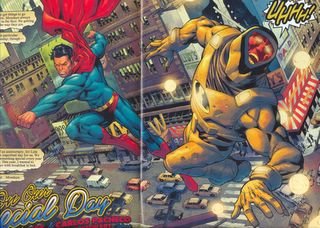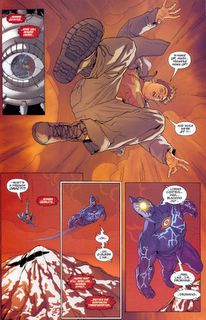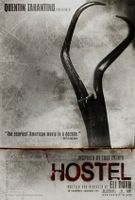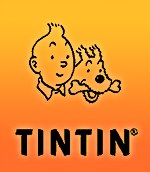Vol. 2, No. 7
- - - - - - - - - - - - - - - - - - - - - - - - - - - - - - - - - - - - - - - - - - - - - - - - In this issue:
In this issue:
reviews of Superman #654-655 and Omac #1-2 / notes on the new DC, that D&D guy, Hostel, The Descent, and Out of Sight / rants about a speedster's stumble and other pull-list casualties
- - - - - - - - - - - - - - - - - - - - - - - - - - - - - - - - - - - - - - - - - - - - - - - -
reviews
Superman #654-55 (DC Comics)
Kurt Busiek (Writer) / Carlos Pacheco (Penciller) / Jesus Merino (Inker) / Dave Stewart (Colorist) / Comicraft (Letters)
My favorite Superman stories have always been those that create a web of criminal and law-enforcement intrigue in Metropolis (Intergang, Gangbuster, Luthor, the Metropolis Special Crimes Unit, S.T.A.R. Labs) and focus on Lois and Clark’s skill as reporters and on their rapport as husband and wife while still giving Superman a chance to throw some punches at a big, cool, supervillain. It’s precisely this focus on the Lois-Clark relationship and the human skills of the protagonists as they explore the Metropolis milieu that makes me think of this Supersubgenre as “the Metropolis story.”
In its classic (and in my view ideal) form, the Metropolis story implicitly restricts the significance of Superman’s powers, which become merely the signifiers of Clark Kent’s moral authority and the pretence for giving the conflict—at heart a 1940s or 50s crime adventure or conspiracy tale—a cool science fiction gloss. It wouldn’t be a Superman story without the SF trappings, but the story itself is really about Clark Kent’s ingenuity as he faces off against crime bosses, crooked billionaires, and secret scientific syndicates. The simulacrum of workaday grittiness that characterizes Superman’s friends and foes in such stories has the effect of rooting Superman in a crime genre that, while artificial in its own right, feels remarkably realistic next to the alien grandeur of Superman himself. This anchoring effect produces a totally unique frisson that is, for me, no less thrilling (though differently so) than a Morrisonian Superman who makes baby suns to feed his pet sun-eater. And it goes without saying, I hope, that Metropolis stories need not take place in Metropolis to qualify. The Metropolis story is not about setting so much as about the extension of a certain storytelling sensibility whose essence is rooted in the juxtaposition between retro criminal intrigue and wild science fiction that finds its purest form in Metropolis stories, but often extends beyond city limits.

Busiek seems to like these kinds of stories as much as I do. His first two solo-written issue of Superman (#654 and #655) are absolutely packed with classic Super-goodness. The first story, “On Our Special Day,” features a satisfying tour of Metropolis and the Daily Planet offices; deftly introduces new S.C.U. division, “The Science Police”; makes a point of sidelining a silly villain like the Prankster in favor of dust-ups with Neutron (a perfect third-string Superman foe) and a mysteriously mutated Intergang Boss Mannheim (a perfect second-string Superman foe); establishes a tantalizing mystery (who is the “them” behind Mannheim’s mutation and dangerous new gadget?); resurrects not one but two old flames of Clark’s (Lana in a surprising new role and news-to-everyone “arcanobiologist” Callie Llewelyn); and best of all, frames all this fun with a pitch-perfect snapshot of Lois and Clark’s ironclad relationship.

Lois’s discovery of a half-made anniversary breakfast, her unflappable response to the radio report explaining Clark’s absence, her needling of Clark over his old flame Callie, her final surprise for Clark at the end of the day—all of this serves as Busiek’s sweet (but not saccharine) reminder of why Clark Kent loves Lois Lane and why their happy marriage is such a delight to behold.
The final scene of the issue’s main story, of Lois and Clark (not Lois and Superman) taking to the sky to reprise their first dance in the clouds twelve years earlier, is magical, and sets the tone, I think, for the kinds of stories Busiek seems interested in telling. At least, I hope it does. And I think I have cause for optimism, given that one of the most significant plot points of the issue is the (re)establishment of two other women from Clark’s past in significant roles. Hopefully the prominence of Lana and Callie signals some enjoyable testing of Lois and Clark’s relationship in the near future.
The fact that the entire issue is organized around the conceit of “Mondays” is an artful touch. While punching Neutron in the face, Superman ironically remarks of Mondays, “You try and you try to get things to go smoothly, but somehow, Mondays always manage to smack you in the face.” Over the course of the issue, this becomes a running joke about the bad-luck Clark experiences—not only is his anniversary breakfast interrupted by Neutron, his Daily Planet assignments are interrupted by a variety of super-threats that seem to spell deadline disaster for Clark. The point of all this is of course to reveal Lois as the one thing that makes “Mondays” (and all the headaches and responsibilities they stand for) endurable for Clark. More broadly, however, “Mondays” are also an appropriate beginning for Busiek’s run as series writer because Metropolis stories in their classic form are in a sense about the ordinariness connoted by “Mondays”: they emphasize the parochial human dilemmas and banal challenges of being both Clark Kent and Superman, as opposed to, say, the sublimity and awe that characterize Morrison’s more mythic, even mythological approach to the same material. This is why these stories emphasize the ordinary human face of crime and justice in Superman’s world, often featuring super-powered variations on regular blue- or white-collar criminals and organized crime, rather than more outlandish science-fiction villains. And when they do feature wilder SF supervillains like Darkseid, their presence is often delayed by or folded into the apparatus of petty crime, criminal undergrounds, and military science conspiracies. We see exactly this type of thing in “Cold Comfort,” the gripping next issue (Superman #655), which features Superman’s encounter with Subjekt-17, apparently the monstrous leftover progeny some secret Soviet science lab with some as yet veiled connection to Arion, Lord of Atlantis. All of which is to say that Busiek understands what makes classic Metropolis Superman stories fun and unique: layers of criminal and scientific intrigue to be navigated by ace reporters, all anchored by the Lois and Clark love story, with a dollop of superheroics thrown in for good measure.
And I haven’t even mentioned Pacheco and Jesus Merino’s glorious art. My god, does this book look fantastic, or what? When Pacheco was drawing Green Lantern, his art was pared down and austere. I once made the case that this was a deliberate aesthetic choice, but seeing his work on Superman I almost wondered if maybe he was just bored. Lois, Clark, Jimmy, Perry, Lana, and the rest haven’t looked this slick in ages. Pacheco’s Metropolis hums with life. The villains and guest stars look great too, particularly Neutron (whom Pacheco draws with a wonderful Kirbyesque face, as if to suggest not just the amorphousness of “radiation in a man-shaped suit” but also the sheer power of this villain). Subjekt-17 is a creepily-rendered Hellboy reject. And Arion is suddenly cool. (Apparently, to be cool, you just need to be drawn as a sort of latter-day Count Orsino or Vicomte Sébastien de Valmont, lazing in bed with two gorgeous women. Fanboys are such an easy bunch, aren’t we?)

There are so many nice touches in this comic—among them the use of the cover to Action Comics #841 for Metropolis tabloid, Action Bulletin News and, on the same page, the most envy-provoking use of Superman’s power’s I have ever seen: the implanting of the page of a paperback thriller (“the latest John Sandford novel”—a Da Vinci Code rip-off?) with microdots that hold the complete texts of other books—“science, history, philosophy, current issues”—that Clark can read with super-vision and then commit to super-memory. Now THAT’s a fantasy that I can relate to. It’s also a nice nod to the play between pulp fiction (the Sandford novel) and reality (science, history, philosophy, current issues) that is the very stuff of comic books in general and of Metropolis stories in particular.
Kurt, Carlos, Jesus...take a bow.
Omac #1-2 (DC Comics)
Bruce Jones (Writer) / Renato Guedes (Artist and Colorist) / Phil Balsman (Letterer)
By all rights I shouldn’t like Omac at all. Despite my nearly infinite willingness to defend Infinite Crisis, not even I could defend the utter lameness of the Omacs—surely one of the silliest visual designs of recent times. They made me laugh, not shudder, and I was dismayed to see that their presence in the DCU was going to be perpetuated beyond the passing of the Crisis. And then the Brave New World Special made me think again. The new Omac series by Bruce Jones and Renato Guedes is as gripping as it is gorgeous—and it is damn gorgeous. Guedes inks and colors his own work and the results are stunning; he draws a little like Geoff Darrow, inks mainly outlines, and uses a subtle color palette in areas of both light and shadow, giving the action a soft, coherent delicacy. Heck, he even makes the ridiculous Omac suit look neat and occasionally menacing, and if that isn’t a testament to his artistic skill, I don’t know what is! His people look great, but his real specialty is drawing streets and buildings. The action of issue #1—in which seventeen-year-old junkie Mike Costner discovers that he is “the last Omac”—takes place within a truly impressive array of concretely visualized inner-city settings. This kind of visual concreteness is everywhere in DC’s books these days: Pete Woods’s beautiful Metropolis settings, for example, and the incredibly detailed training academy in the Green Lantern books. Part of the much touted “brightness” and “sharpness” of the new DCU comes from this attention to setting, and I hope that DC’s amazing stable of artists doesn’t let up on this kind of attention to detail because it makes a huge difference to the quality of the storytelling.
And the story of “last Omac” has so far been a blast. Jones has created an appealing underdog hero in Mike and is currently putting him through his paces in a very interesting way: whenever the Omac armor takes him over (Brother Eye needs to get this back-up “sleeper” Omac unit to an Alaskan NORAD facility in order to repair itself) Mike loses most—but not all—of his bodily control and risks going from petty thief to murderer. In other words, Jones is clearly playing the Omac armor as a metaphor for the destructiveness of drug addiction and the loss of control that addiction entails. At the same time, Jones keeps a wry, often satiric eye trained on the pervasiveness of addiction in contemporary culture and on the ambiguous issue of criminalizing drug use. In the first issue, he uses the conceit of Brother Eye’s scanning of the neighborhood for its missing Omac to identify, among other things, traces of nicotine, alcohol, and marijuana in the cops—with a nod to the medical marijuana lobby on page seven. A very nice elaboration of the central theme.
Beyond the clever welding of the addiction theme to the parasitic alien armour premise, Omac is just plain good reading—good reading that is significantly enhanced by the racial diversity of its cast, something that DC has been particularly vocal about lately. Jones writes realistic often very funny dialogue, and he makes superb use of two prominently-featured guest stars: Firestorm (Jason Rusch) and Cyborg (Vic Stone).

In addition to being one of DC’s most complex and interesting black heroes, Cyborg is one of the few older Titans without his own series that deserves more exposure, if not a crack at an ongoing title; likewise, the new Firestorm series by Stuart Moore, Jamal Igle, and Keith Champagne, has turned Jason Rusch into one of DC’s brightest new characters. It’s a sad comment on what the state of minorities in comics has been that it actually feels novel and exciting to have not one but two black superheroes guest-starring in the same book—but there it is. Geoff Johns has been subtly pushing this agenda on JSA using this strategy of multiplication (Mister Terrific, Jakeem Thunder, Crimson Avenger) for some time now, and I’m delighted by the prominence of Black Adam and the introduction of the Chinese team of heroes in 52. In most of these cases, the work of diversification has been to strike a delicate balance between proclaiming and deemphasizing the significance of race—of making an impression without necessarily foregrounding the fact of racial or cultural difference as a point of plot—though not ruling out that possibility either. DC’s general approach to this—and I think it’s a good one—has been to emphasize character complexity and multiply differences across many characters, producing, for example, not a single new Chinese hero, but a whole team of Chinese heroes. The Cyborg-Firestorm team-up in Omac is another instance of this strategy. On its own, the assignation of more culturally-diverse guest-spots would hardly be a solution to the overarching problem of racial and cultural diversity in comics but in this context it begins to address the imbalance and moves away from a more conventionally tokenistic approach to black characters, particularly in a story that juxtaposes black heroes with a white drug addict.

If you’re enjoying the new DC, then chances are you’re savoring Omac for some of the same reasons I am. If you haven’t yet been tempted, Omac is a great place to hop on board. Here’s hoping the creative team sticks around to make this outstanding miniseries an ongoing—or better yet, that they launch a Cyborg series when they wrap up their eight-issue run on this one.

notes
The New DC: There’s No Stopping Us Now!
In case it wasn’t clear from the reviews above, I dig the post-Crisis DCU. 52 is like a drug and the relaunches of the flagship titles of major characters like Batman, Superman, Wonder Woman, and Green Lantern have been impressive to say the least. What really gets me, though, is the number of incredible NEW titles I’m suddenly buying, starring heroes (and villains) I barely know. If you’d asked me a couple of years ago to predict what would be at the top of my pull list today, I certainly wouldn’t have guessed Omac, Checkmate, Firestorm, Uncle Sam and the Freedom Fighters, Secret Six, or Blue Beetle. But there they are, and the list just keeps growing…
I’ve rhapsodized about Omac already, and it’s no surprise that I think highly of Gail Simone and Brad Walker’s dark, cheeky follow-up to the Villains United soap opera (can’t wait to see what Gail does with dysfunctional first-family the Doom Patrol next month), but what about Greg Rucka and Jesus Saiz’s super-espionage extravaganza or Jimmy Palmiotti and Justin Gray’s Grant Morrison-inspired satire of Homeland Security in America? Not only are their stories topical, exciting, and smart, these series all do a superb job of marrying writing and art. I was skeptical at first because I loved Dale Eaglesham, but Brad Walker has completely won me over. His loose, lush pencils are a perfect fit with Gail’s twisted, erotic, emotionally gripping storytelling in Secret Six. Saiz brings an appropriate level of gritty realism to Rucka’s intrigue laden spy-scripts, and Daniel Acuna’s hyperreal Norman Rockwell style is such an ingenious choice for bringing Morrison, Palmiotti, and Gray’s American satire to life that I am dumb with admiration.
Among DC’s more standard superhero books, Firestorm and Blue Beetle really stand out. Stuart Moore and Jamal Igle’s Firestorm is slick superhero drama with an emphasis on great characters and classic superhero action. Keith Giffen, John Rogers, and Cully Hamner’s Blue Beetle is even better. I don’t care that much for the new Beetle armor, but the new Blue Beetle himself, teenager Jamie Reyes, and his friends Paco and Brenda are such an entertaining and authentically imagined trio that I’ve been hooked since the first issue. Set in El Paso and drawn with an indie flare by Hamner (and guest artists Cythia Martin and Duncan Rouleau), the series has so far been concerned with setting up mysteries concerning a gang “extras” (metahumans) named “The Posse” and a sinister metahuman collector named “La Dama” and her magician-henchman. The Phantom Stranger has also appeared to offer gnomic teases about Jamie’s place in the new age of magic (following the events of Day of Vengeance). This is classic “with great power comes great responsibility” stuff, but with a totally modern sensibility. Jamie Reyes is the first teenaged protagonist to come along in some time who truly captures the spark of a Peter Parker. The Beetle armor needs a redesign, but this series certainly deserves to be a big, fat mainstream hit.
The Basement Elf: Boomerang Poster-Boy?

Despite a few lunch-hour D&D skirmishes in junior high and a brief flirtation with the ElfQuest RPG in high school, I’ve never really been much for fantasy games, but this IS a sensational ad. Aside from the guy’s priceless expression, posture, and droopy right eye, the basement/dungeon overlap is inspired, making a nifty play on the stereotype of the geek who’s “still living in his parent’s basement.” Interesting that it’s caught the attention of zeitgeist-meter Boing Boing. I wonder if its attention-grabbing resonance isn’t due as much to its capturing of the ennui of the boomerang generation as to its intrinsic cleverness. Or maybe it’s just that we all feel a little stunned by all our face-time with the world wide web, regardless of whether we play online games or not. Friends? Come over? You mean...in person?
The Screening Room: Recently Viewed
Hostel – I really enjoyed this. And so, to my surprise, did my squeamish wife (who initially lost all respect for me, but then promptly caved in and watched over my shoulder, fleeing from the room for the nasty bits). Despite being well-acted and attractively shot, it received mixed reviews, especially from disappointed horror fans who wanted more torture and defilement. Certainly the fact that the film was tamer than I’d expected made it much easier to watch for folks like us who are, um...a little less hardcore in our cultivation of Slovakian dungeon porn. The real selling point for me, though, was that the film layered its obvious exploitative charms with a dead-on satire of sex-tourism and the suppressed homosexual panic that attends certain rituals of male bonding. In this regard, the film’s central reversal manages to be both harrowing and amusing, right down to the bloody details—Paxton’s “castrating” loss of his two fingers and his subsequent (consequent) failure to genuinely rescue the girl. The only significant weakness was the film’s failure to capitalize on Paxton’s flight from the sadists’ gulag, which should have been more suspenseful. Nonetheless, far more interesting than expected.
The Descent – The tension level during the first hour of this film was so high that I was actually relieved when the scary things in the cave finally made an appearance. Je-sus! This is a smart, scary, nail-biter of a horror picture with riveting performances by its all-female cast. I’m terrified of small spaces (a recurring nightmare of mine is of being chased through the collapsing and ever-narrowing passageways of a university building until I get trapped—I wonder what that could mean?) so this movie was a fairly excruciating experience from the get-go. Cave-diving? Not for me. Especially not now. The director-approved ending change makes the film’s periodic birthday cake crosscuts seem superfluous, but the original British ending which makes sense of the damn cake doesn’t really make complete sense either—at least, not if you like your twists to be of the fair-play variety, which I do. Ultimately though, it doesn’t really matter. This is great character-driven horror by a director (Neil Marshall) who understands suspense and isn’t shy about playing nasty. The most unsettling scene? Not the lake of blood (which was awesome) but the horrible, horrible surprise that awaits Sarah at the window in the cabin... Upsetting and nerve-wracking...but in a good way.
Out of Sight – If it’s been awhile since you’ve watched Steven Soderbergh’s most successful exercise in style and wit, do yourself a favor and rent it again. Jennifer Lopez is unbelievably good as Federal Marshall Karen Sisco and George Clooney couldn’t be more charming as escaped bank robber Jack Foley. The scenes between them—in the car trunk and in the hotel bar—are so natural and so genuinely romantic that you forget for a few moments that this is all just pretend. I guess that’s what they call chemistry, not to mention a great script. The fact that Soderbergh swiped the cross-cutting technique of the bar conversation with the bedroom consummation from the brilliant sex scene in Don’t Look Now (a theft Soderbergh fesses up to in the largely skippable director’s commentary) in no way harms the immediacy of these magical soft-focus scenes. Needless to say, this movie had me from the opening freeze-frame. Watching it again made me pine for the short-lived but superb TV spin-off, Karen Sisco, that starred Carla Gugino in Lopez’s role. There’s a TV DVD that needs releasing.

rants
Annnnndddddd...he’s off! DOH!
I hate to be an asshole, but the new Flash is barely out of the gate and already the relaunch has been a stumble. It’s at the very least ironic that the fastest man alive is getting the slowest start imaginable for his new series, which is mired in exposition and choppy storytelling. I was willing to give a pass to the first issue, but things really haven’t improved very much in issue two. A large part of the problem is Bart’s sped-up metabolism, which has aged him prematurely. This kind of thing can work in TV soap operas because the intimacy of the medium (five episodes a week) allows you to become involved with the suddenly grown-up character very quickly. In comics however, the much slower monthly schedule militates against this kind of rapid re-involvement, especially when the character in question already has a substantial history. Exacerbating the problem of identification is that the suddenly-older Bart has simultaneously undergone a significant personality transformation. In other words, this new Bart literally feels like an alienating soap-opera recast—not only has the character been artificially aged, he’s also being taken “in a new direction” by an actor who bears no resemblance to the earlier versions. I realize that there’s supposed to be some kind of mystery about the identity of the new flash and that Bart might not be it; the problem is that the story has been so alienating that I don’t much care who the new Flash is. Truth be told, I’ve never really been much of a Flash fan. I only started reading because I was transfixed by the artwork of Scott Collins, and ended up staying because of Geoff Johns’s fantastic scripts. The new team had better pick up the pace, if they want to hang onto readers like me. You know…the curious, but uncommitted.
Tales from the Pull-List: Endangered Books
I mentioned above that I’ve been buying tons of new comics, which means that unless I suddenly win the lottery, something’s gotta give. I’ll be sticking with the new Flash series for awhile to see if it can find its legs but it’s fallen to the bottom of the pile and it’s certainly not the only comic on the endangered list.
I was originally ecstatic about Bill Willingham’s double duty as writer/artist on Shadowpact, but after four-issues and two guest artists, I’m wondering if it might not be time to get the series on a more even keel by finding a full-time penciller. I loved seeing old-favorite Blue Devil in solo action again this month, but moody, atmospheric visuals are essential to a magic-oriented series and not even Willingham seems quite in tune with the weird majesty of Justiano’s Day of Vengeance visuals. Also, I hate the superhero costumes on Enchantress and the chimp. There, I said it.
I really, Really, REALLY want to like this, but the All New Atom series is clearly going to be a perverse test of my love for Grant Morrison and Gail Simone. I’m trying to be mature about it.
I’ve been getting JSA: Classified since the beginning and added JLA: Classified to my pull list after that breathtaking Ellis/Guice arc, but after the recent Detroit League saga in JLA: Classified, which is now being follwed by a sort of “sequel” in JSA: Classified, it’s beginning to look like DC needs a reminder about how easy it is to alienate readers from satellite series like the “Classified” ones. Remember a little book called Teen Titans Spotlight that was launched to capitalize on the success of that team back in the mid-80s? Remember how BAD that was? It drove even the most slavering fans away. Things haven’t quite come to that in the JLA and JSA Classified series, but it is asking A LOT of readers to sign on for what appears to be a seven or eight-issue Steve Englehart/Tom Denerick Detroit-League mini. I’m all for revisiting the Detroit League characters and I’m a huge fan of Steve Englehart—I even realize that these are in a sense “period” pieces. But these stories do not meet the high standard that has been established for the Classified series so far.
Oh, AQUAMAN. I just don’t know. I shouldn’t have to try so hard to enjoy this. It doesn’t help that I have to reread the entire series each time a new issue comes out (every two months?) to remember who these characters are.
Off the list: Hawkgirl (a catastrophe), Legion of Superheroes (for real this time), Nightwing (I tried it; I don’t get it), Outsiders (good riddance).
















13 comments:
I'm willing to give the Flash another few issues on the off chance this is an art problem for me. I let my sister read the first two, and she loved them. The major difference between our tastes is that she forgives bad art much more easily than I do. I saw a preview of the next issue on Scans_Daily, and the artist there is much more to my taste.
Many thanks for that link, ragnell - I hadn't seen any of those pics before. I too prefer Karl Kerschl's art style, and if he is the new regular artist that would certainly go a long ways towards bringing the Flash up to the level of DC's other marquee properties. Is it just me, or does DC seem to be developing a more fluid and "pretty" house-style in general? This would fit right in.
I have never screamed while watching a film before---not even as a child. The Descent made me scream three times. Luckily I was in a cinema full of people who were all on the same level. Marshall is the Hitchcock of scary cinema, and I highly recommend his debut, Dog Soldiers, as well.
Jim, I'm with you on the quavering finances. Although I'm a bit less tolerant than you. I've dropped series I sort of liked instead of just those I didn't like. Like Green Lantern Corps. I like it, but I can live without it. I'm trying to hit a few new titles to replace stuff I felt I was just buying to read "something" I thought I would enjoy. I finally picked up Manhunter and actually want to start hunting down the back issues.
david - I don't know if my pal will forgive me for disclosing this, but he had to leave the theater halfway through the film, moments before the crawlers appeared. I thought, "Damn, what a rotten time for a pee-break"--but I was wrong. Turns out, he'd gone to the consession stand to get some frozen yogurt and just chill out for a bit. It's a scary movie that will make a grown man flee to the consession for the comfort of Yogen Fruz! (Sorry C!) And thanks for that Dog Soldiers recommendation - I will get it for sure.
jon - Every now and then, when I'm flush, I think: "Isn't it great that I can buy almost whatever comics I want." But what usually happens is that I end up buying a whole bunch of comics that are only semi-pleasing. I actually really enjoy the belt-tighening process insofar as it makes you really choose only the very best titles on your list. But you're right - I'm still being way too tolerant. More may fall from the list soon. GL Corps stays for me because I'm infatuated with Gleason's art. I'm sort of on the fence about Manhunter. After it received a stay of execution, I went out and bought about five back issues, but haven't read them yet. Should do.
(“the latest John Sandford novel”—a Da Vinci Code rip-off?)
It's not clear whether you know this from how you phrase it, but John Sandford's a real author. My father likes his stuff.
I don't have enough spare money to get anywhere near the amount of comics I get. If it was up to me I'd be getting about half of DC's line. As it is, I'm getting 52 and Justice League and am trying a few other things, but may have to drop them. The only thing I'm getting that I know I'll never drop is Legion.
Hey, matthew, thanks for the John Sanford correction. I honestly had no idea! (And was apparently too lazy for a google-check.) Actually, his books look like fun, so I take the cheap Da Vinci Code shot back!
Loved your description of "the Metropolis story". It reminds me of the Superman cartoon episode "The Late Mr. Kent" -- probably the best of the series.
Thanks, nobody; I actually haven't seen any of the Superman cartoons--maybe I should rent them. I'm not a big animation watcher, but I did enjoy a brief flirtation with the Teen Titans (shock!).
Superman wasn't always as great as the Batman series, but some of them are quite good. The three-part Worlds Finest" story is one of the best Bats/Supes team-ups ever, and you might cry tears of joy when you see the end of the first episode.
Another good one is "Brave New Metropolis," which depicts an alternate universe in which Superman and Luther are co-dictators in a fascist state. All of these (including The Late Mr. Kent) are in the Volume Two collection, though World's Finest is also available alone as "The Batman/Superman Movie".
I don't have Volume Three but I know there's a great episode on that one called Knight Time, in which Bruce Wayne disappears without a trace, prompting Superman to put on Batman's costume and clean up Gotham a bit. Talk about giving Batman's urban myth a boost on the street!
That sounds like a lot of fun, nobody--thanks! I was in Zellers a couple of days ago checking out the Superman cartoons (somehow, that sounds sadder than I meant it to) and wondering which was the best of the volumes they had. I have to go back for some stuff this weekend, so I'll give Volume Two another look. I could use some tears of joy right about now!
Try the early issues (around 80-100) of Waid's run on Flash. I think you'll like them.
Thanks for the recommendation, shane. I'll keep my eye out for them!
Post a Comment